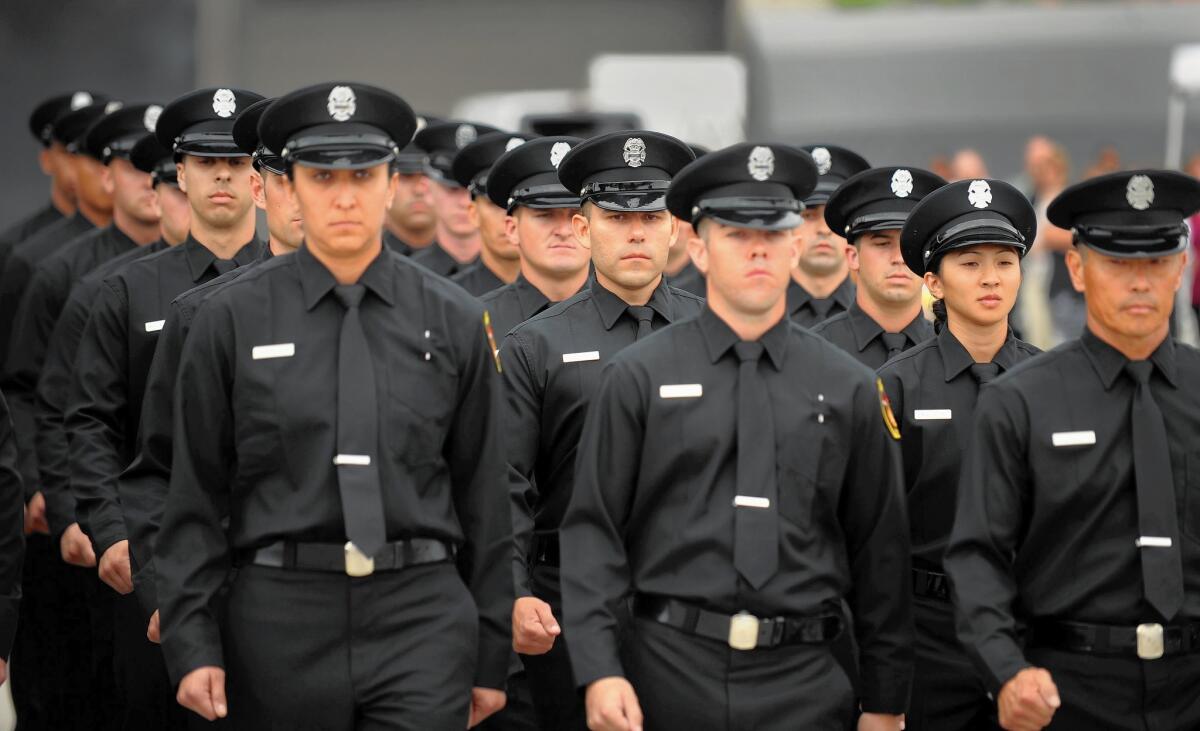Why the LAFD is still largely white and male despite diversity efforts

L.A. city firefighter graduates are seen in August. Mayor Eric Garcetti’s overhaul of how the city hires new firefighters has so far failed to meet his aim of diversifying the LAFD.
- Share via
Los Angeles Mayor Eric Garcetti’s overhaul of how the city hires new firefighters - launched 16 months ago amid allegations of nepotism and bias - has so far failed to meet his aim of diversifying the LAFD and may require further reforms to succeed, according to interviews with city officials and a Times analysis of government data.
In March of last year, the mayor halted hiring at the Fire Department after a series of Times reports prompted him to condemn the city’s selection methods as “fatally flawed.”
Soon after, Garcetti retooled the process, vowing to introduce more women and minorities to the ranks of an agency that remains primarily white and overwhelmingly male.
But new data released by city officials show that the first four classes of recruits hired under the rebooted system have fallen far short of the numbers needed to achieve Garcetti’s goal of a department that more closely resembles the city it serves.
The lack of progress has heightened calls, from both inside and outside City Hall, to reconsider a centerpiece of the mayor’s program: a blind lottery that now winnows down the massive pool of candidates seeking coveted slots in the city fire service.
Under the Garcetti administration system, 202 recruits have entered the grueling boot camp that is the final step to becoming a city firefighter. Of those, virtually every racial group except white males is underrepresented when compared with the city’s population.
The percentage of African-American firefighters, boosted in past decades by court orders and targeted hiring, is due to decline because only 13 black people have made it into the recent training classes, short of what’s needed to offset retirements and attrition.
“We’re looking at a dire situation,” said Capt. Cheyane Caldwell, a leader in the Stentorians, a group that has represented black firefighters since the days of segregated firehouses. “We have a lot of black chiefs hired in the 1980s - and once they’re out, our numbers will have a drastic decline.”
There also has been little progress toward the decades-old goal of hiring more women at the department. Despite repeated calls from elected leaders for reform, the percentage of female LAFD firefighters remains at slightly less than 3% — the same as in 1995.
In past years, the LAFD has been roiled by allegations of gender bias, and advocates for increasing the number of female firefighters say the department needs to be more welcoming to women with the necessary skills.
Thirteen women were selected as recruits in the four most recent academy classes, but only two have finished the rigorous boot camp where potential hires must pass drills that simulate a fire and manipulate heavy ladders, hoses and tools. Some remain in training, but several failed to graduate and two recent classes finished with no women remaining.
The department’s rank and file has become more racially diverse in recent decades, but about half of the roughly 3,200 uniformed LAFD employees are white in a city that’s 28% white.
Peter Sanders, an LAFD spokesman, said the agency “is working hard to continually refine its recruiting process to better reflect the city that we serve.” Battalion Chief Alicia Welch is leading an expanded recruitment effort, he said, adding that the department is partnering with the L.A. Unified school district on a first-ever high school magnet program that prepares students for city firefighter jobs.
Connie Llanos, Garcetti’s press secretary, restated the mayor’s commitment to having the LAFD and other city agencies reflect the makeup of the city. The steps being taken “show decent progress,” she said, “but the department must continue to be aggressive in reaching out proactively to the best candidates from all backgrounds, to avoid the mistakes of the past.”
State law forbids governments from setting hiring quotas for women and minorities, and city officials say programs such as the new magnet school are the best hope of increasing future diversity by enticing more members of underrepresented groups to apply.
There has been no shortage overall of applicants for firefighter positions, which offer a six-figure salary and generous pension.
More than 10,000 people applied when the city restarted hiring last year after a hiatus. White men dominated the applicant pool. Only 5% were women, city data show, limiting the likelihood a large number would advance through testing and interviews to be hired.
We don’t have a recruitment problem. We have a problem recruiting certain types of people.
— Fire Commissioner Jimmie Woods-Gray
“We don’t have a recruitment problem,” said Fire Commissioner Jimmie Woods-Gray. “We have a problem recruiting certain types of people.”
Fire Chief Ralph M. Terrazas has delivered to the city Fire Commission a plan to revitalize the department’s outreach efforts. The panel is scheduled to consider it Tuesday. Terrazas has vowed to double the number of women at the LAFD by 2020.
His new effort would assign more staff to recruitment, hire an advertising firm to create a social media campaign, develop a program to better prepare female and minority candidates and send firefighters to connect with potential applicants at trade schools, military bases and women’s professional sporting events.
The changes have been welcomed by labor groups and city leaders, although some wonder whether they will be enough to significantly alter previous hiring patterns.
“This is not doing it,” Caldwell said. “They need to look at a way that’s going to get the numbers to where they need to be.”
The previous recruit screening process was halted last year after The Times reported that thousands of candidates were excluded because key paperwork wasn’t received by the city in the first minute of a filing period. Many applicants said they had no idea mere seconds would determine which candidates would advance.
Nearly one-third of the 70 recruits eventually selected in that hiring round were related to LAFD firefighters, and the group’s makeup was overwhelmingly white. It included only one woman, who later dropped out.
In response, Garcetti hastily backed changes to the hiring process that included the use of a lottery intended to winnow down the large applicant pool in a more impartial manner.
Because the drawing does not take qualifications into account, candidates with relevant experience or those carefully groomed by the recruitment process have the same chance as anyone else.
“Why are we treating the public sector different from the private sector?” said Capt. Steve Tufts, an LAFD veteran and former union head.
Tufts and others say the city should consider more specific job qualifications to ensure that those best equipped are selected in the lottery. Candidates currently are given no advantage if they have a college degree, previous firefighting experience or certifications such as a paramedic license.
Recruitment efforts targeted at qualified minorities would then stand a better chance of success, he said.
“The goal here is to bring in people who are really highly competitive,” said Chaitra Hardison, the lead author of a Rand Corp. study on LAFD hiring commissioned by Garcetti last year. “It would be better to find them before you do the lottery.”
A new round of adjustments to the screening process may be coming as the city’s Personnel Department prepares to issue a call for applicants next year, said Bruce Whidden, executive director of the city’s civil service commission.
“I think [the lottery] was a little too radical for the city to adopt as a permanent solution. It was almost unprecedented,” Whidden said. “There’s going to be a change.”
The upcoming hires will join a force charged with fighting fires within the city limits, but also one that performs many less physically demanding tasks. The latter include handling 911 calls, enforcing the fire code and responding to the medical emergencies that have become the bulk of the department’s work.
In many other cities, those tasks are assigned to civilian employees, which, among other things, tends to result in more women being hired.
Approximately 16% of uniformed officers of the San Francisco Fire Department are female, according to a department spokeswoman, and 911 calls are handled by civilian dispatchers, many of them female.
In Los Angeles, all paramedics are firefighters. In San Francisco not all firefighters are paramedics. That’s why their numbers are so different.
— Bruce Whidden, executive director of the city civil service commission
“In Los Angeles, all paramedics are firefighters. In San Francisco not all firefighters are paramedics. That’s why their numbers are so different,” Whidden said. “Here, they all need to be able to throw a ladder and carry someone over their shoulders.”
Like the LAFD, departments in other cities have faced long-running controversies over hiring. Costly court judgments that found discriminatory practices have been handed down in New York and Chicago in recent years.
“This is a nationwide issue. We do not have the silver bullet,” Caldwell said. “This is a conversation that’s been going on since segregation.”
ALSO
After days of protests, students occupy building at Occidental College
No reliable way to track L.A. police on tax-free full salary injury leave, audit finds
L.A. could fund sidewalk repairs in front of businesses
More to Read
Sign up for Essential California
The most important California stories and recommendations in your inbox every morning.
You may occasionally receive promotional content from the Los Angeles Times.











